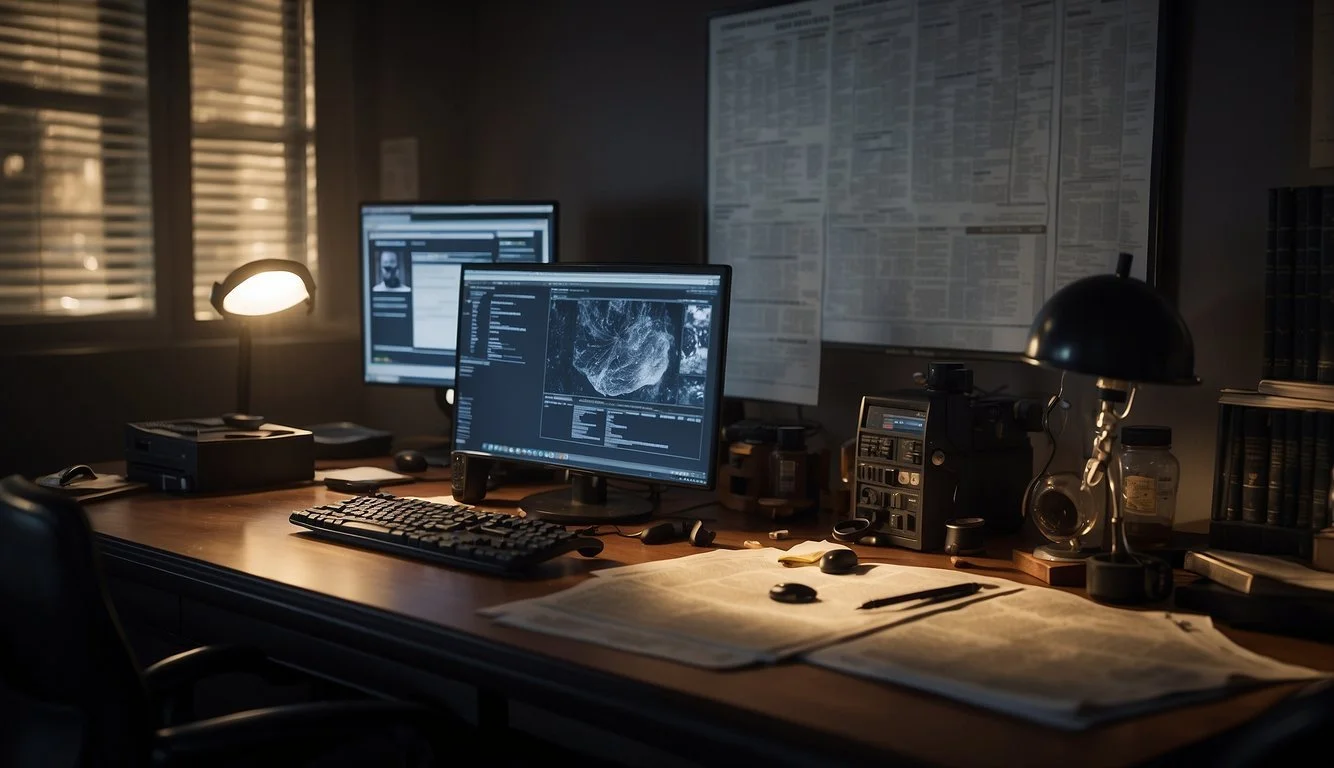Documentary Review: Catching Killers (2023)
An In-Depth Analysis
"Catching Killers" Season 3 delivers gripping true crime stories with a steady focus on the investigators' perspectives. This season, available on Netflix, continues its tradition of exploring high-stakes cases through interviews with law enforcement professionals who lived through the pursuit of dangerous criminals. Each episode offers a close look at the challenges and breakthroughs faced by those who work to bring justice to the victims.
The latest installment, consisting of four episodes, reconnects fans with the series' intimate storytelling style. Viewers are taken through detailed accounts of complex investigations that highlight both the relentless determination and emotional toll experienced by officers. As the narrative unfolds, the series emphasizes the moments of resolution when killers are caught, offering a measure of closure.
For true crime enthusiasts, "Catching Killers" Season 3 maintains the same compelling format as its predecessors. The new season ensures that the harrowing yet fascinating world of crime investigation remains engaging. The melding of personal experiences and professional insights provides a rich, comprehensive look at the relentless pursuit of justice.
Synopsis of 'Catching Killers'
“Catching Killers” delves into the intricate details of law enforcement's pursuit of some of the most notorious serial killers in American history. The documentary provides insight into the methods and challenges faced by investigators.
Overview of the Documentary
“Catching Killers” is a gripping true crime docuseries available on Netflix. Each season explores the harrowing journeys of detectives and law enforcement as they track down serial killers. The new season retains its format of four episodes, each detailing a distinct case from initial investigation to final arrest.
The series does not just narrate the crimes but delves deeply into the process, showcasing the complexities and emotional toll on those involved. Viewers get to witness both the procedural aspects and the personal experiences of investigators.
Central Themes
The primary theme of “Catching Killers” is the painstaking process of investigation. This includes gathering evidence, profiling suspects, and navigating legal hurdles. It highlights the relentless pursuit of justice, emphasizing that each case is a blend of forensic science, intuition, and dogged determination.
Another significant theme is the emotional impact on law enforcement and victims' families. The series frequently revisits the human cost of these crimes, ensuring that victims are not forgotten and presenting the enduring effects on communities. The focus on both procedural and emotional aspects makes the series compelling and informative.
Production Insights
The production of Catching Killers (2023) remains consistent with its predecessors, maintaining a balance between visual storytelling and narrative depth. Each aspect, from direction to editing, contributes to a cohesive viewing experience.
Directorial Vision
The directorial vision of Catching Killers Season 3 remains focused on presenting true crime stories with a sense of realism and empathy. The directors make a deliberate choice to emphasize the human impact of the crimes, often framing narratives from the perspective of law enforcement officers and victims' families. This approach ensures that the series not only entertains but also educates and respects the gravity of the content. Directors Charles Coffey and others maintain a steady hand in pacing the revelations, ensuring viewers are continuously engaged.
Cinematography
Cinematography in Catching Killers Season 3 plays a crucial role in immersing the viewers into the world of crime investigation. The series uses dark, moody lighting and close-up shots to create an intense and sometimes claustrophobic atmosphere, which mirrors the chilling nature of the cases being presented. Visuals are carefully curated to highlight key pieces of evidence and pivotal moments in investigations. This technique serves to bring watchers closer to the investigative process, making them feel like they are part of the unfolding story.
Editing and Pacing
Editing and pacing in Season 3 of Catching Killers are executed with precision. Each episode follows a structured format, ensuring a seamless flow of the narrative. The series expertly balances its runtime between exposition and climax, avoiding unnecessary filler while maintaining viewers' interest. Flashbacks and real-time storytelling are interwoven effectively to provide context without overwhelming the audience. The pacing is measured, allowing the gravity of each captured moment to resonate before moving on to the next phase of the investigation. This method enhances the overall impact of the series, making it both informative and engaging.
Critical Analysis
Catching Killers (2023) presents a well-structured narrative, delving deeply into its subject matter while examining significant cultural and social impacts.
Narrative Structure
The series adopts a four-episode format, each ranging between 30 to 45 minutes. Through a blend of police and eyewitness accounts, the story unfolds methodically. Each episode maintains a tight focus, providing a cogent sequence of events. This structure aids in building suspense and maintaining viewer engagement. The methodical progression through investigative phases mirrors real-life procedural pacing, allowing viewers to follow the complex processes involved in tracking down criminals.
Subject Matter Examination
Catching Killers delves into the intricate details of pursuit and capture of notorious criminals. The third season, for instance, expands its focus to cover four distinct killers. The inclusion of personal experiences from law enforcement enhances the authenticity. The cases span various timeframes, some involving killers active for many years. This approach underscores the painstaking and often prolonged nature of criminal investigations, offering viewers a realistic portrayal of the challenges faced by investigators.
Cultural and Social Impact
The series taps into the cultural fascination with true crime, contributing to ongoing discussions about criminal justice and investigative processes. By spotlighting real cases, it highlights the dedication and resilience of law enforcement. This can evoke a sense of appreciation among viewers for the often under-recognized efforts of these professionals. Additionally, the series may provoke thought and debate regarding the systemic issues within criminal justice systems, such as prolonged investigations and resource allocation. By presenting these real-world challenges, Catching Killers fosters a deeper understanding and potentially drives conversations around necessary reforms.
Interviews and Contributors
Catching Killers (2023) provides valuable insights through interviews with a variety of key participants. These contributors range from experienced law enforcement officials to survivors and eyewitnesses directly impacted by the events.
Experts Featured
In this series, viewers hear from top experts involved in solving the highlighted cases. These include police officers, detectives, and forensic specialists, each bringing unique perspectives and detailed recounts of their investigative processes. For example, officers who worked tirelessly on the murders near Green River discuss the strategies and obstacles they faced. Forensic analysts offer detailed explanations on how evidence was collected and analyzed, underpinning the crucial role of technology in solving cases.
Interviewees also shed light on the emotional and psychological aspects of their work. They reveal the intense pressure and commitment required to track down serial killers. Such personal accounts provide depth, allowing viewers to understand the complex nature of investigative work.
Survivors and Witnesses
Survivors and witnesses play a crucial role in the narrative of Catching Killers (2023). Their testimonies breathe life into the series, adding a human element to the factual recounting of crimes. Victims’ families offer poignant memories and reflections, emphasizing the profound impacts these tragedies had on their lives.
Eyewitnesses recount their experiences with remarkable detail, helping to piece together the events leading to the capture of the perpetrators. These first-hand accounts are vital for understanding the broader social and emotional context of the crimes. Their stories not only contribute to the narrative but also honor the resilience and courage of those directly affected by the violence.
Viewer Reception
Viewer reception for Catching Killers (2023) highlights mixed opinions and evaluations that reflect various aspects of audience engagement and critique. Ratings show a divergent reception, with notable trends in both positive and negative feedback.
Audience Responses
Audiences have shared a range of reactions towards Catching Killers Season 3. True crime enthusiasts generally find the series engaging due to its focus on gripping real-life cases. Many appreciate the detailed accounts from law enforcement and witnesses, which add depth to the storytelling.
However, some viewers feel that the series becomes repetitive and lacks fresh content compared to previous seasons. Criticisms also include the episodic structure, which some found too short to fully explore each case.
Overall, audience responses are split, mirroring the varied tastes and expectations within the true crime fan community.
Ratings and Reviews
The series has garnered a mixed set of ratings from various review platforms. Ready Steady Cut rated it 2.5/5, noting that it remains average and does not stand out among other true crime docuseries. Similarly, Rotten Tomatoes features mixed reviews, with some critics highlighting its engaging aspects while others point to its shortcomings.
Additionally, The Review Geek mentions the adherence to the previous seasons' format, with four episodes each focused on different killers. They also note the inclusion of candid guest moments as a positive aspect.
These varied reviews indicate a series that appeals to a niche audience while facing criticism for its execution and content delivery.
Comparative Analysis
This section examines how "Catching Killers" compares to other documentaries in the genre and its influence on true crime storytelling. The analysis highlights the distinctive features and areas where it might resonate with or differ from similar works.
Similar Documentaries in Genre
"Catching Killers" positions itself alongside several prominent true crime series available today. Making a Murderer and Mindhunter delve into intense investigations and the psychology of criminal minds.
While "Catching Killers" focuses on police and eyewitness narratives, shows like The Confession Tapes and The Ted Bundy Tapes explore the procedural aspects and personal accounts of offenders.
Mindhunter offers a more dramatized portrayal, whereas Catching Killers stays within the documentary framework. Each series appeals differently depending on the viewer's interest in details and narrative style.
Contributions to True Crime Narratives
"Catching Killers" adds fresh perspectives on infamous criminals with each season, addressing cases like the Railroad Killer and the D.C. Sniper. Its format of using firsthand police and witness accounts provides authenticity, differing from more dramatized or sensationalized approaches seen in other series.
By extending its focus to more killers per season, "Catching Killers" offers comprehensive insights into multiple cases. This method of storytelling contributes to a nuanced understanding of complex criminal investigations.
Its emphasis on detailed case studies and factual storytelling enriches the true crime narrative landscape, providing valuable content for enthusiasts seeking in-depth examinations of criminal behavior and law enforcement efforts.
Educational Value
Catching Killers (2023) offers significant educational value through its meticulous examination of criminal investigations.
The series delves into the methods and techniques employed by law enforcement agencies when tracking down serial killers. Viewers gain insight into criminal profiling, forensic analysis, and interrogation strategies.
By presenting real-life cases, the documentary conveys the complexities and challenges faced by investigators. This realistic portrayal aids in understanding the nuances of criminal psychology and the operational procedures of law enforcement.
Educational Aspects:
Forensic Science: Detailed demonstrations of evidence collection and analysis.
Criminal Psychology: Exploration of the mental states and behaviors of perpetrators.
Law Enforcement Tactics: Step-by-step walkthroughs of investigative strategies.
The incorporation of expert commentary bolsters the educational value. Interviews with seasoned detectives and criminologists provide context and deeper understanding.
Catching Killers is also valuable for those studying criminal justice. The real-world applications of theoretical concepts serve as useful case studies for students and academics.
The concise presentation of information makes complex topics accessible. The series avoids sensationalism, focusing instead on factual and procedural accuracy. This approach ensures that viewers receive an informative and balanced perspective.
Additionally, the emphasis on victim remembrance underscores the human element, fostering empathy and a greater appreciation for the impact of criminal justice work.
Ethical Considerations
Catching Killers (2023) raises several ethical questions given its intense subject matter and real-life implications.
Depicting true crime stories inevitably involves portraying sensitive and often traumatic events. It is crucial for the series to approach these stories with respect and sensitivity. The privacy and dignity of the victims and their families must always be prioritized.
Consent is another significant consideration. All individuals involved, including survivors and families of victims, should give explicit consent for their stories to be shared. Without this, the series risks ethical violations and further emotional harm.
Portraying criminals and their actions can unintentionally glorify or humanize these individuals. The series must take care not to sensationalize crime or give undue attention to the perpetrators in a way that overshadows the victims' experiences and the societal impact.
The show's creators also face the challenge of maintaining accuracy versus dramatization. Sticking to verified facts and avoiding embellishment helps maintain integrity and trustworthiness, important for both ethical and journalistic standards.
Engagement with law enforcement and experts must be conducted with transparency. This ensures that the information presented is both credible and respectful to those who have investigated and addressed these crimes.
Ethical production practices must be considered in the choice of reenactments and visual content. Avoiding graphic or overly detailed depictions of violence minimizes potential distress to viewers and respects the gravity of the events being portrayed.
Concluding Thoughts
Season 3 of Catching Killers continues the trend set by its predecessors. The series maintains its focus on recounting the methods used by law enforcement to track down notorious serial killers.
The narrative style remains factual and straightforward, primarily driven by police and eyewitness accounts.
This season comprises four episodes, each digging into the complex investigation processes.
What sets this season apart is its extended focus; instead of three killers, four are examined. This broader scope allows for a more comprehensive view.
Despite the expanded range, the series keeps its concise episode format intact.
The show's production quality is consistent, making it visually engaging for true crime enthusiasts.
While not universally praised, as some reviews suggest mixed reactions, the series accomplishes its goal of presenting detailed criminal investigations.
True crime aficionados may find this series particularly compelling.
Each episode effectively highlights the relentless pursuit of justice by law enforcement.
Though its format may seem repetitive to some, its dedication to factual storytelling remains unaltered, providing a reliable source of true crime content.






